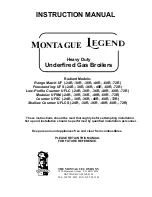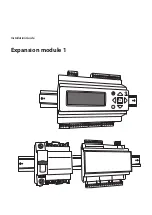
Finned copper tube gas boilers & water heaters – Boiler Manual
23
Figure 19
HeatNet Control Panel
21. Monitor the flame current on the 7800. No flame current should
be detected and the 7800 should lock out. If flame current is
detected at any time up to the 7800 locking out, the 120V wiring
on the ignition transformer must be reversed and the test run
again to insure that no flame is detected.
Improper wiring of the ignition transformer can result
in an explosion causing extensive property damage,
severe personal injury or death!
22. Open main isolation gas valve (field supplied).
23. Reset the Honeywell 7800. The boiler will start and will run
at minimum input rate.
24.
Setting the low fire:
Allow the low fire to settle out for a few
minutes and observe the combustion reading. Refer to “Combustion
Reading” tables 14 and 15 for proper combustion readings and
table 16 and 16a for proper elbow pressure signal at low fire.
Table 14 Combustion Readings (Category I)
Natural Fuel
Propane Fuel
CO
2
%
8.0 - 8.2 (min.)
9.4 - 9.6 (min.)
8.2 - 8.5 (100%)
9.6 - 9.9 (100%)
O
2
%
6.6 - 6.2 (min.)
6.6 - 6.2 (min.)
6.2 - 5.8 (100%)
6.2 - 5.8 (100%)
For factory set gas manifold (elbow) pressures see label on
inner cabinet door.
Table 15 Combustion Readings (Category II and IV)
Natural Fuel
Propane Fuel
CO
2
%
8.0 - 8.5 (min.)
9.4 - 9.9 (min.)
8.8 - 9.8 (100%)
10.3 - 11.5 (100%)
O
2
%
6.6 - 5.8 (min.)
6.6 - 5.8 (min.)
5.2 - 3.5 (100%)
5.2 - 3.5 (100%)
For factory set gas manifold (elbow) pressures see label on
inner cabinet door.
Table 16 Elbow Pressure signal (Nat Gas) - Category I
Firing
rate
%
500
750
1000
1250
1500
1750
2000
Signal
Inches
wc
Signal
Inches
wc
Signal
Inches
wc
Signal
Inches
wc
Signal
Inches
wc
Signal
Inches
wc
Signal
Inches
wc
100%
N/A
-4.4
-8.2
-3.7
-5.8
-7.3
-8.5
85%*
-3.1
-7.1
-3.2
-3.8
-6.2
-6.8
To determine signal in mm wc, multiply signal pressure by 25.4.
* Maximum turndown on units listed as CAT I
Table 16a Elbow Pressure signal (Nat Gas) - Category II and IV
Firing
rate
%
500
750
1000
1250
1500
1750
2000
Signal
Inches
wc
Signal
Inches
wc
Signal
Inches
wc
Signal
Inches
wc
Signal
Inches
wc
Signal
Inches
wc
Signal
Inches
wc
100%
-2.2
-4.5
-7.1
-4.3
-6.0
-8.5
-8.7
33%
-0.5
-0.6
-0.7
-0.6
-0.8
-1.0
-1.0
25%
-0.2
-0.3
-0.5
-0.3
-0.5
-0.6
-0.6
To determine signal in mm wc, multiply signal pressure by 25.4.
Correctly identify the type of vent system the appliance
requires before proceeding. Category identification is
noted on the unit rating plate.
The low fire O
2
-CO
2
can be adjusted in the field by opening the
low fire adjustment door located on the forward facing side of the
main gas valve, see Figure 20. Inserting an allen wrench and rotating
the allen screw clock-wise will increase the CO
2
and lower the O
2
,
rotating counter clock-wise will decrease the CO
2
and increase the
O
2
.
DO NOT LEAVE THE BURNER IN AN INFRARED
STATE.
A few random speckles of red are fine, but large
concentrations of spots or large areas of red are not. If large amounts
of red concentrations are observed, verify combustion readings.
25. Jumper the “AA” terminals located on the HeatNet control board. The
boiler input will rise to its maximum input, “Run 100%”, see Figure 22.
26. Allow the boiler to reach steady state and verify supply gas
pressure and check input rates as explained in the “Gas Supply
Piping” section. Also, refer to “Combustion Reading” tables 14
and 15 for proper combustion readings, and table 16 and 16a
for proper elbow pressure signal at high fire. The high five trim
is located on the outlet flange of the gas valve, see Figure 20.
O
2
-CO
2
can be adjusted by inserting a screw driver and rotating
clockwise to increase the CO
2
and lower the O
2
. Rotating
counterclockwise will decrease the CO
2
and increase the O
2
.
27. Remove jumper “AA” and allow boiler to settle into minimum
input. Observe the combustion readings and make any final
adjustments. When finished disable the Low Fire Hold Switch
and replace test ports to normal state.
28. Boiler allows for many modes of operation and control methods.
Reference the “HeatNet Control Manual”.
















































